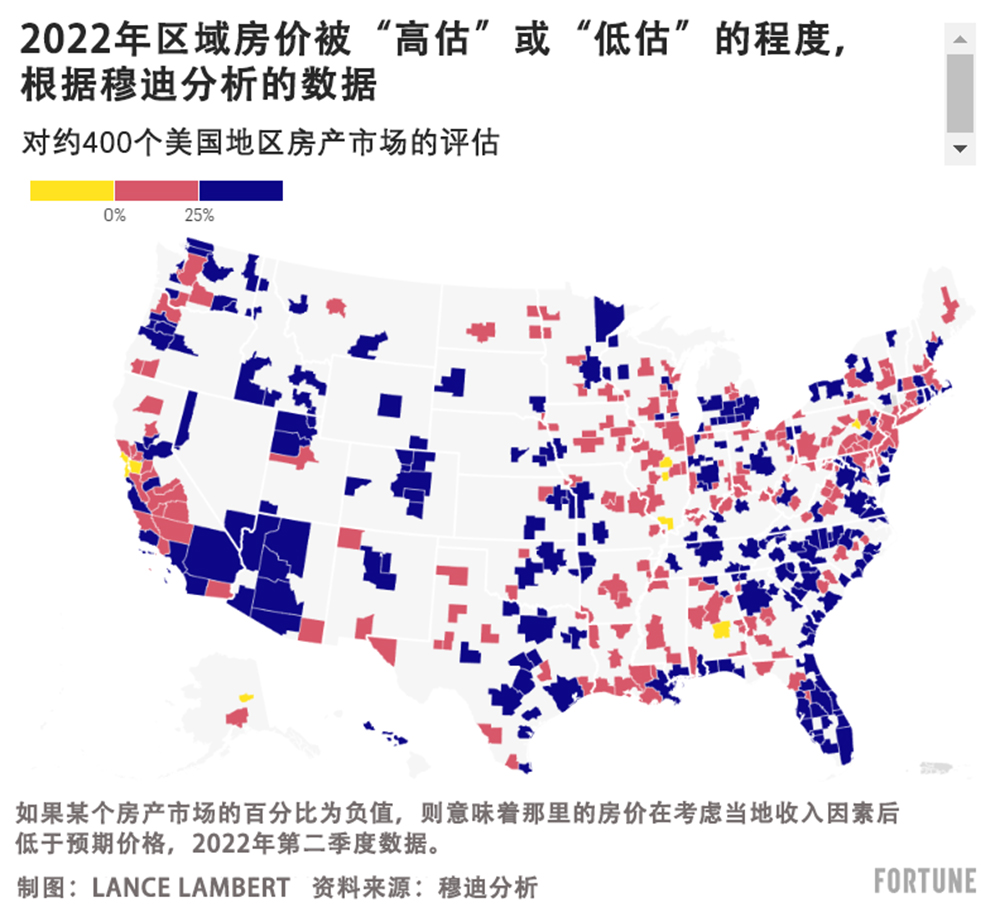當然,,穆迪分析(Moody’s Analytics)的首席經濟師馬克·贊迪并不贊同上述看法。今年5月,,贊迪就對《財富》雜志做出了一個大膽的預測:疫情房產熱已經見頂,,而且我們將進入“房產修正期”。在這期間,,與房貸利率3%掛鉤的房市將向供求平衡邁進,。期間,,房屋銷量將急劇下滑,。贊迪表示,在此期間,,美國大部分地區(qū)都會出現(xiàn)房價修正風險,。
從9月的情形來看,贊迪的房產市場修正預言似乎完全正確,。不僅房產活動出現(xiàn)了大面積的下滑,,同時在一些市場,例如奧斯汀和博伊西,,房價也出現(xiàn)了下滑,。上周,美聯(lián)儲(Federal Reserve)的主席杰羅姆·鮑威爾承認,,美國房產市場將進入“艱難的修正期,。”
盡管如此,,贊迪的看法愈發(fā)悲觀,。8月,,穆迪分析下調了美國房產市場展望。穆迪分析預計,,美國房價從峰值到谷底的跌幅區(qū)間為0至5%,,而價格嚴重“高估”房產市場的跌幅區(qū)間為5%至10%。8月的預測并沒有考慮經濟衰退因素,。如果經濟進入下行通道,,穆迪分析預計美國房價的跌幅就將達到5%至10%,而價格嚴重“高估”房產市場的跌幅將達到15%至20%,。
僅僅一個月之后,,穆迪分析再次下調了這一房市下行展望。
穆迪分析如今預計美國房價從峰值到谷底的跌幅區(qū)間為5%至10%,。在價格嚴重“高估”的房產市場,,預測的跌幅為10%至15%。如果發(fā)生經濟衰退,,穆迪分析預計美國房價跌幅就將擴大至10%至15%,,而價格嚴重“高估”的房產市場的跌幅將達到20%至25%。
假設美國房價下跌15%,,顯然這一跌幅并不能夠徹底抹除美國房價在疫情房產熱期間出現(xiàn)的驚人的43%增幅,。然而,它將是二戰(zhàn)后出現(xiàn)的第二高房價跌幅,,僅次于美國房價在2006年至2012年房產泡沫破滅期間出現(xiàn)的27%的跌幅,。
如果美國房價確實出現(xiàn)雙位數(shù)跌幅,《財富》雜志將把疫情房產熱重新稱之為疫情房產泡沫(Pandemic Housing Bubble),。

這些價格被嚴重“高估”的市場都在哪,?實際上,幾乎無處不在,。
每一個季度,,穆迪分析都會評估當?shù)亟洕久媸欠衲軌蛑萎數(shù)胤慨a價格,其中包括當?shù)厥杖胨健?如果某個房產市場被“高估”的幅度超過了25%,,穆迪分析就認為其價格被“嚴重高估”,。2022年第一季度,在全美413個最大的地區(qū)房產市場中,,有183個的高估幅度超過了25%,。第二季度,這個數(shù)字增長到了210個,。
在疫情房產熱早期階段,,這些泡沫市場主要集中在陽光帶地區(qū)和西山地區(qū)新興城鎮(zhèn)。然而,,隨著房產熱進入2022年,,很多西海岸,、中西部和東北地區(qū)的房產市場也開始出現(xiàn)了價格泡沫。

從歷史上來看,,泡沫房產市場(即嚴重“高估”的市場)在房市修正期出現(xiàn)房價下跌的風險最高,。正因為如此,穆迪分析每一個季度都會對分析進行更新,。
如果房價修正(受房貸利率大幅上漲3個百分點的刺激)在兩年前發(fā)生,,那么就可能會存在房價下跌風險的房產市場數(shù)量就會少得多。在2019年第二季度(見上圖),,僅有三個首要房產市場被認為嚴重“高估”,。
簡而言之:在不到三年的時間中,美國房市從歷史上平易近人的房市(見下圖)變成了歷史上令人敬而遠之的房市,。

當然,,這場房價修正運動已經啟動了。受影響最嚴重的莫過于兩種房產市場,。
第一種屬于奧斯?。?月至8月房產價值下跌了7.4%)、博伊西(下滑5.3%),、丹佛(下滑4.3%)和菲尼克斯(下滑4.4%)這類泡沫市場,。這些市場的一些買家來自于舊金山和紐約這類城市,個個財大氣粗,。在他們的推動下,,這些地區(qū)的房價已經遠超歷史上當?shù)鼐用袷杖肟梢猿惺艿姆秶_@些正是被穆迪分析視為存在高風險的房產市場,。
第二種屬于西雅圖(5月至8月房價下跌了3.8%)舊金山(下滑7.8%)和圣何塞(下滑10.6%)這類高成本科技中心,。假如考慮當?shù)厥杖耄@些市場并不屬于被嚴重“高估”的范疇,。然而,,這些市場會遭受雙重噩夢的打擊,。首先,,這里的高端房產市場對利率更加敏感,其次,,其所處的科技領域亦是如此,。
這些房產市場何時才會觸底?贊迪稱,,此次房價修正可能會持續(xù)12個月至18個月,。
穆迪分析的首席經濟師馬克·贊迪寫道:“穆迪分析房屋估值方法是實際房價與符合歷來人均薪資和建造成本的房價之間的百分比差值。房價最終由用于修建房屋的土地價格決定,,而且與按照薪資以及房屋建造成本衡量的土地機會成本掛鉤,。在全美范圍內,,房屋約一半的價值來自于土地,另一半價值取決于結構,,但不同地區(qū)存在著巨大差異,。比如在舊金山,土地在房屋價值中的占比最大,,而且大得離譜,,在愛荷華州得梅因,情形剛好相反,。我們的房產估值方法亦考慮了這些差異,。”(財富中文網(wǎng))
譯者:馮豐
審校:夏林
有鑒于有利的千禧一代人口結構,,房產庫存的吃緊以及較低的失業(yè)率,,房地產看漲人士稱,疫情房產熱(Pandemic Housing Boom)還有更多的上行空間,。
當然,,穆迪分析(Moody’s Analytics)的首席經濟師馬克·贊迪并不贊同上述看法。今年5月,,贊迪就對《財富》雜志做出了一個大膽的預測:疫情房產熱已經見頂,,而且我們將進入“房產修正期”。在這期間,,與房貸利率3%掛鉤的房市將向供求平衡邁進,。期間,房屋銷量將急劇下滑,。贊迪表示,,在此期間,美國大部分地區(qū)都會出現(xiàn)房價修正風險,。
從9月的情形來看,,贊迪的房產市場修正預言似乎完全正確。不僅房產活動出現(xiàn)了大面積的下滑,,同時在一些市場,,例如奧斯汀和博伊西,房價也出現(xiàn)了下滑,。上周,,美聯(lián)儲(Federal Reserve)的主席杰羅姆·鮑威爾承認,美國房產市場將進入“艱難的修正期,?!?/p>
盡管如此,贊迪的看法愈發(fā)悲觀。8月,,穆迪分析下調了美國房產市場展望,。穆迪分析預計,美國房價從峰值到谷底的跌幅區(qū)間為0至5%,,而價格嚴重“高估”房產市場的跌幅區(qū)間為5%至10%,。8月的預測并沒有考慮經濟衰退因素。如果經濟進入下行通道,,穆迪分析預計美國房價的跌幅就將達到5%至10%,,而價格嚴重“高估”房產市場的跌幅將達到15%至20%。
僅僅一個月之后,,穆迪分析再次下調了這一房市下行展望,。
穆迪分析如今預計美國房價從峰值到谷底的跌幅區(qū)間為5%至10%。在價格嚴重“高估”的房產市場,,預測的跌幅為10%至15%,。如果發(fā)生經濟衰退,穆迪分析預計美國房價跌幅就將擴大至10%至15%,,而價格嚴重“高估”的房產市場的跌幅將達到20%至25%,。
假設美國房價下跌15%,顯然這一跌幅并不能夠徹底抹除美國房價在疫情房產熱期間出現(xiàn)的驚人的43%增幅,。然而,,它將是二戰(zhàn)后出現(xiàn)的第二高房價跌幅,僅次于美國房價在2006年至2012年房產泡沫破滅期間出現(xiàn)的27%的跌幅,。
如果美國房價確實出現(xiàn)雙位數(shù)跌幅,,《財富》雜志將把疫情房產熱重新稱之為疫情房產泡沫(Pandemic Housing Bubble)。
這些價格被嚴重“高估”的市場都在哪,?實際上,,幾乎無處不在。
每一個季度,,穆迪分析都會評估當?shù)亟洕久媸欠衲軌蛑萎數(shù)胤慨a價格,,其中包括當?shù)厥杖胨健?如果某個房產市場被“高估”的幅度超過了25%,穆迪分析就認為其價格被“嚴重高估”,。2022年第一季度,,在全美413個最大的地區(qū)房產市場中,有183個的高估幅度超過了25%,。第二季度,,這個數(shù)字增長到了210個,。
在疫情房產熱早期階段,,這些泡沫市場主要集中在陽光帶地區(qū)和西山地區(qū)新興城鎮(zhèn)。然而,隨著房產熱進入2022年,,很多西海岸,、中西部和東北地區(qū)的房產市場也開始出現(xiàn)了價格泡沫。
從歷史上來看,,泡沫房產市場(即嚴重“高估”的市場)在房市修正期出現(xiàn)房價下跌的風險最高,。正因為如此,穆迪分析每一個季度都會對分析進行更新,。
如果房價修正(受房貸利率大幅上漲3個百分點的刺激)在兩年前發(fā)生,,那么就可能會存在房價下跌風險的房產市場數(shù)量就會少得多。在2019年第二季度(見上圖),,僅有三個首要房產市場被認為嚴重“高估”,。
簡而言之:在不到三年的時間中,美國房市從歷史上平易近人的房市(見下圖)變成了歷史上令人敬而遠之的房市,。
當然,,這場房價修正運動已經啟動了。受影響最嚴重的莫過于兩種房產市場,。
第一種屬于奧斯?。?月至8月房產價值下跌了7.4%)、博伊西(下滑5.3%),、丹佛(下滑4.3%)和菲尼克斯(下滑4.4%)這類泡沫市場,。這些市場的一些買家來自于舊金山和紐約這類城市,個個財大氣粗,。在他們的推動下,,這些地區(qū)的房價已經遠超歷史上當?shù)鼐用袷杖肟梢猿惺艿姆秶_@些正是被穆迪分析視為存在高風險的房產市場,。
第二種屬于西雅圖(5月至8月房價下跌了3.8%)舊金山(下滑7.8%)和圣何塞(下滑10.6%)這類高成本科技中心,。假如考慮當?shù)厥杖耄@些市場并不屬于被嚴重“高估”的范疇,。然而,,這些市場會遭受雙重噩夢的打擊。首先,,這里的高端房產市場對利率更加敏感,,其次,其所處的科技領域亦是如此,。
這些房產市場何時才會觸底,?贊迪稱,此次房價修正可能會持續(xù)12個月至18個月,。
穆迪分析的首席經濟師馬克·贊迪寫道:“穆迪分析房屋估值方法是實際房價與符合歷來人均薪資和建造成本的房價之間的百分比差值,。房價最終由用于修建房屋的土地價格決定,而且與按照薪資以及房屋建造成本衡量的土地機會成本掛鉤。在全美范圍內,,房屋約一半的價值來自于土地,,另一半價值取決于結構,但不同地區(qū)存在著巨大差異,。比如在舊金山,,土地在房屋價值中的占比最大,而且大得離譜,,在愛荷華州得梅因,,情形剛好相反。我們的房產估值方法亦考慮了這些差異,?!保ㄘ敻恢形木W(wǎng))
譯者:馮豐
審校:夏林
Favorable millennial demographics. Tight housing inventory. Low unemployment. That’s why housing bulls said the Pandemic Housing Boom had more room to run.
Moody’s Analytics chief economist Mark Zandi, of course, disagreed. Back in May, Zandi came to?Fortune?with a bold proclamation: The Pandemic Housing Boom had peaked and we were entering into a “housing correction.” A housing correction being a period where the housing market—which got priced to 3% mortgage rates—would work towards equilibrium. It’d see home sales volumes fall sharply. It’d also, Zandi said, put much of the nation at risk of a home price corrections.
Fast forward to September, and it looks like Zandi’s housing correction call was spot-on. Not only is housing activity declining across the board, but some markets, like Austin and Boise, are already seeing falling home prices. Last week, Fed Chair Jerome Powell acknowledged that the U.S. housing market is entering into a “difficult correction.”
That said, Zandi’s views are shifting—downward. In August, Moody’s Analytics downgraded their U.S. housing market outlook. Peak-to-trough, Moody’s Analytics expected U.S. home prices to fall between 0% to 5%, and fall between 5% to 10% in significantly “overvalued” housing markets. That August forecast assumed no recession. If an economic downturn manifested, Moody’s Analytics expected U.S. home prices to fall between 5% to 10%. While significantly “overvalued” housing markets would fall 15% to 20%.
Just a month later, Moody’s Analytics is already revising that bearish housing market outlook downward.
Peak-to-trough, Moody’s Analytics now expects U.S. home prices to fall between 5% to 10%. In significantly “overvalued” housing markets, that forecasted drop is now between 10% to 15%. If a recession hits, Moody’s Analytics expects that U.S. home price decline to widen to 10% to 15%, and the drop in significantly “overvalued” housing markets to range between 20% to 25%.
Let’s say that U.S. home prices decline 15%. That hypothetical drop wouldn’t fully erase the staggering 43% jump in U.S. home prices we saw during the Pandemic Housing Boom. However, it would be the second biggest home price decline of the post-World War II era. Only the bursting housing bubble, which saw U.S. home prices decline 27% between 2006 and 2012, would have it beat.
If U.S. home prices do indeed fall by a double-digit amount, Fortune would relabel the Pandemic Housing Boom to the Pandemic Housing Bubble.
Where can we find these significantly "overvalued" housing markets? Well, just about everywhere.
Every quarter, Moody’s Analytics assesses whether local economic fundamentals, including local income levels, can support local house prices.* If a housing market is “overvalued” by more than 25%, Moody’s Analytics deems it “significantly overvalued.” Through the first quarter of the year, 183 of the nation’s 413 largest regional housing markets were overvalued by more than 25%. In the second quarter of 2022, that figure grew to 210 regional housing markets.
During the early phase of the Pandemic Housing Boom these frothy markets were heavily concentrated in Sun Belt and Mountain West boomtowns. However, as the housing boom carried over into 2022, many markets on the West Coast, Midwest, and Northeast also began to reach frothy valuations.
Historically speaking, frothy housing markets (i.e. significantly "overvalued" markets) are at the highest risk of home price declines during a housing market correction. After all, that's why Moody's Analytics updates the analysis each quarter.
If this housing correction—which was spurred by a 3 percentage point jump in mortgage rates—had occurred two years ago, far fewer housing markets would've been at risk of home price declines. Back in the second quarter of 2019 (see chart above), just three major regional housing markets were considered significantly "overvalued."
Simply put: In just under three years, the U.S. housing market went from a historically affordable housing market (see chart below) to a historically unaffordable housing market.
This home price correction, of course, has already started. It's hitting two groups the hardest.
The first group includes frothy markets like Austin (where home values fell 7.4% between May and August), Boise (down 5.3%), Denver (down 4.3%), and Phoenix (down 4.4%). Those markets saw deep-pocketed WFH buyers from cities like San Francisco and New York drive home prices far beyond what local incomes would historically support. These are exactly the types of places Moody's Analytics deems high risk.
The second group are high-cost tech hubs like Settle (where home values fell 3.8% between May and August), San Francisco (down 7.8%), and San Jose (10.6%). Relative to local incomes, those markets are not significantly "overvalued." Those tech hubs are, however, hit by a double whammy. Not only are their high-end real estate markets more rate-sensitive, but so are their tech sectors.
When will these housing markets bottom out? According to Zandi, it could take another 12 to 18 months before this home price correction concludes.
"The Moody’s Analytics housing valuation measure is the percent difference between actual house prices and house prices historically consistent with wages and salaries per capita and construction costs. The price of a house is ultimately determined by the value of the land upon which it resides which is tied to the opportunity cost of the land as measured by wages and salaries, and the cost to build the home. Nationwide, approximately one-half of a home’s value is the land and the other half the structure, but this varies considerably across the country. In San Francisco, for example, the land is far and away the biggest part of the home’s value, while in Des Moines, Iowa, it is the opposite. Our housing valuation measure accounts for these differences," writes Moody's Analytics chief economist Mark Zandi.






